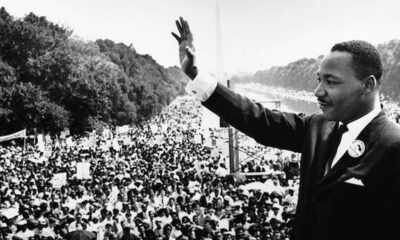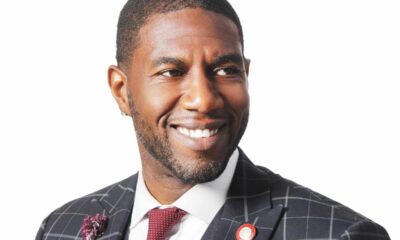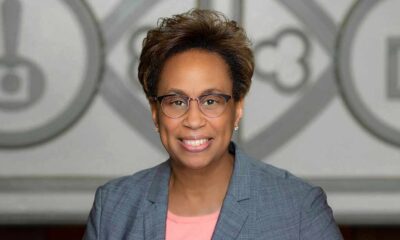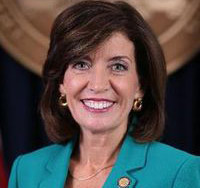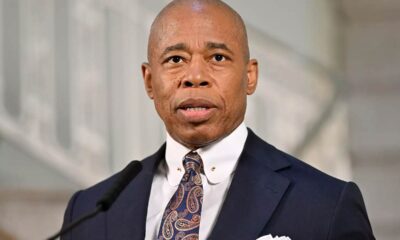Education
Toward the Student-Centered College
 2010 marks 40 years since the founding of Medgar Evers College in 1970. Under the leadership of Edison O. Jackson, the school has created nationally known centers such as the Center for Law and Social Justice, the Caribbean Research Center, the Center for NuLeadership on Urban Solutions, the Ella Baker/Charles Romain Child Care Center, the Center for Women’s Development and the Jackie Robinson Center for Physical Culture. The construction of the Academic Science Center and earlier this year achieving the status of a full-funded CUNY four-year institution are other testaments to his tenure.
2010 marks 40 years since the founding of Medgar Evers College in 1970. Under the leadership of Edison O. Jackson, the school has created nationally known centers such as the Center for Law and Social Justice, the Caribbean Research Center, the Center for NuLeadership on Urban Solutions, the Ella Baker/Charles Romain Child Care Center, the Center for Women’s Development and the Jackie Robinson Center for Physical Culture. The construction of the Academic Science Center and earlier this year achieving the status of a full-funded CUNY four-year institution are other testaments to his tenure.
Now under the stewardship of President William L. Pollard, we asked what are the greatest challenges he faces after only five months on the job. The president was hesitant to speak of particular difficulties, saying the job is “Everything I expected, plus some.”
Asked about the challenges of the incoming class, Pollard says the students in the new class as well as those already attending, “affirm my thinking” regarding his defining goal of Medgar Evers College being “the leading student-centered school in the CUNY system.” He says that the decisions he’s making in terms of personnel or the physical plant, are in line with that student-centered vision. “I want us to be first and foremost a college that is pro-student.” and that changes are being made “not necessarily to benefit faculty or staff, but to benefit the students.”
The first example he offers is that “in order for the campus to be more student-centered, it has to be more technologically efficient than it has been.” In order to achieve that, “We have to have a chief information officer who can help us make better decisions about technology to bring our software and hardware more closely aligned with the needs of the students. The technology we have now is not well-thought-out and it’s not of benefit to students or faculty and administration. The technology hire is designed to help students, first and foremost.”
Another hire will be a chief financial officer with the title Assistant Vice-President for Finance, to deal with a legacy financial system that he finds cumbersome. “We currently have a structure that has the president making virtually every financial decision in the college. And while the president is responsible for the decisions made, if I have to buy robes for the choir, or popcorn poppers for the gymnasium basketball games, when do I have the time to reflect on what the needs are for the institution more broadly? I have to get away from the nickel-and-dime decision-making. The only way I can do that is to put the financial house in a kind of order and direct it in a way that allows for greater decision-making at the unit level. It’s at that level that student needs are taken into greater consideration.”
Pollard will also be hiring an assistant vice president for the physical plant, so that decisions can be made and projects can move forward without the direct involvement of the president’s office.
As part of his student-centered vision, President Pollard opens his office to students on Friday afternoons and Tuesday evenings. With this procedure, “I get to hear firsthand what the students are concerned about. As a result, there are things that I’m able to pass on to faculty and staff that allows them to be much more responsive and supportive of students.” Pollard explains that “if we’re going to ask students to take classes on Saturday and Sunday and in the evenings, we have to have office hours to answer the needs of the students. That’s student-centered.”
The president makes clear who is in charge of the school. “Student-centered does not mean student-run. It means we have to be responsive to students, and give them direction so that they make decisions with care and forethought.” Some of those decisions involve how students dress and behave and he mentions that, “At Morehouse, the president has told the young men they can’t wear baggy pants or do-rags. At Lincoln, the president has decided that the university has to take more responsibility to help the students make better decisions on what they eat.”
Rather than issue an edict, President Pollard has chosen to engage the students in dialogue about their future and the steps they need to take to get there. “I’ve had a couple of town hall meetings with students and engaged in conversations on what students ought to look like and how they ought to behave if they’re going to be Medgar students,” and while the president has not established a formal dress code at Medgar Evers College, he is challenging the students to begin reflecting more about their appearance and their roles as young men and women as they move into the future.
President Pollard is very protective of his students and bristles at the fact that “We’ve heard people talk about ‘nontraditional’ students. I don’t believe we have nontraditional students at Medgar, we have students, who for reasons of the economy, for reasons of age and circumstance, have to take non-traditional means to get a college education.
“They may not enter right after high school. They may enter college with family and personal obligations that make their road to a degree longer. taking 5,6,7 8 or 9 years.” This contributes to lowering the school’s graduation rate, but not for any failure on the part of the school or student.
One example he speaks of is a student in the biology department who is studying the nervous system of shellfish. In the course of that research, he’s seen that magnesium has a negative effect on the nervous system of human beings, causing Parkinson Syndrome-like hand tremors. “In some people, it is not Parkinson’s but an overabundance of magnesium in the body.” This student’s research is looking at how to manipulate the amount of magnesium in the body to control tremors.
“This young man is 28 years old. His mother and father had a difficult divorce. He dropped out of school 8-9 years ago so that he could help his mother take care of his siblings and himself. Is this a nontraditional student, or a student taking a nontraditional path? He never lost sight of what he needed to do and he’s now a biology major who will graduate next year.”
Asked if the building boom at the college was over for a moment while he concentrates on other issues, President Pollard says, “We are not finished with the building boom.” Pollard expresses a deep appreciation for the amount of work, patience and willpower that Dr. Jackson exerted in bringing the new buildings into being on the MEC campus saying, “I understand what it took politically and personally to reach this point and that it represents a 10-12-year effort” and yet he said, and he was sure that Dr. Jackson would agree, “The college needs that space again.”
“We are not finished with the building boom and we’re still light years away from where we want to be technologically.”
High on his list is the need for a student center. A place with meeting rooms, food franchises, student government offices and a comfortable location for students to sit and talk between classes. “When you drive by the school and see students out on the street, it’s because we need a student center where the young people can congregate.” And again, this is part of his student-centered vision. “Any building boom has to include a plan for total student development: spiritual, mental and physical.” Along with the student center, Pollard insists there is a need for a field house and playing field as well. He feels that those who think that intramural sports are not integral to higher education miss the learning experiences inherent in sports and that the social skills learned on the soccer field are useful in the boardroom. “Young people learn how to lead, how to work in teams and are prepared to work in structured environments such as the society presents.”
“I want my legacy to be that Medgar becomes the leading student-centered college in the CUNY system. One marked by students who know and believe they are the most important thing at the college. It will be reflected in the way we treat them, reflected in improved graduation rates, reflected in the office hours for faculty and staff, and in the way students are accorded courtesies and conveniences in the evening and on weekends.”



